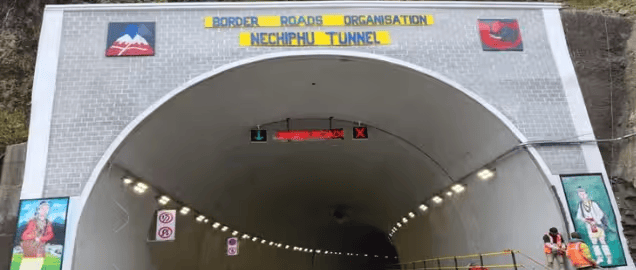Transforming India’s Border Infrastructure
GOVERNANCE
2/15/2024


India’s border infrastructure plays a critical role in ensuring national security and territorial integrity. Regrettably, prior to 2014, successive governments had largely neglected this crucial aspect. This neglect had an adverse effect on India’s ability to deploy troops effectively, leading to vulnerabilities along the borders. Recognizing the urgency of addressing this gap, the Modi government embarked on a mission to enhance border connectivity and fortify India’s strategic locations.
Since assuming office in 2014, PM Modi’s government significantly increased the budget for the Border Roads Organization (BRO) to accelerate the construction of strategic roads along India's borders. The annual budget for BRO has been ramped up four-fold from Rs. 3,782 crore in 2013-14 to Rs. 14,387 crore in 2023-24. As a result, compared to 3,610 km in 2008-14, 6,806 km of border road was constructed between 2014-22.
Moreover, a project to build a Frontier Highway spanning 1,800 kilometers along the China border has commenced. Furthermore, Indian Railways is constructing strategic rail lines in the Northeast region to facilitate the swift mobilization of the Indian army. Work is also progressing on a new rail line linking Kashmir to the rest of India.Additionally, the construction of new air force landing strips has greatly enhanced the mobility of troops and tanks, allowing for quicker responses to conflicts. Indian Air Force (IAF) now boasts 25 airfields capable of launching operations into China. All IAF airfields are receiving hardened aircraft and equipment shelters. In eastern Ladakh, airfields are being established or upgraded in DBO, Fukche, and Nyoma. In Arunachal Pradesh, new airfields have been built in Tezu, Pasighat, and Holongi, while the Ziro airfield has been upgraded, all with dual-use potential. These roads, highways, railways and airfields not only facilitate swift mobilization of forces and supplies but also play a crucial role in enhancing border surveillance and security.
In addition to physical infrastructure, the Modi government has prioritized the deployment of advanced technologies and surveillance systems all along the border. The implementation of the Comprehensive Integrated Border Management System (CIBMS) along the India-Pakistan and India-Bangladesh borders is a testament to India's commitment to leveraging technology for border management. This includes the installation of high-tech border fencing, sensor-based monitoring systems, and unmanned aerial vehicles (UAVs) to strengthen border security and surveillance along India's international borders. The Modi government has also announced plans to install a fence along the entire 1643-kilometer-long border between India and Myanmar. Furthermore, the approval for 4G-based mobile services at 1117 border outposts has enhanced communication capabilities in border areas.
Beyond security considerations, the government's efforts have also focused on promoting socio-economic development in border regions. Initiatives such as the Vibrant Villages Program (VVP) have been approved for villages situated in 46 blocks of 19 districts abutting the northern border in the States of Arunachal Pradesh, Sikkim, Uttarakhand, Himachal Pradesh and UT of Ladakh. The VVP initiative aims to improve infrastructure, healthcare, education, and livelihood opportunities for residents living in border areas, and 663 villages have been identified for coverage on priority. By investing in infrastructure projects and social welfare schemes, the government seeks to address the developmental disparities between border regions and the rest of the country, fostering a sense of security and belonging among border communities.
Improved connectivity and modernization of border infrastructure have fortified India's capacity to deter external threats and effectively address security challenges along its borders. This includes facilitating increased patrols by Indian troops and enabling quick deployment of reinforcements during potential conflicts. With enhanced mobility and surveillance capabilities, Indian security forces are now better prepared to protect the nation's territorial integrity and sovereignty, thereby bolstering India's defense posture amid a volatile geopolitical landscape.
This is evidenced by the increased number of confrontations in sensitive zones of India’s northern frontier, which has unsettled China. For instance, despite Chinese attempts to pressure India into halting the construction of a crucial bridge in the Galwan Valley, India has demonstrated resilience by completing the bridge. This assertive stance not only indicates Indian Army's enhanced capability to monitor, detect, and respond to PLA activities but also sends a clear message to India’s adversaries that India will fiercely protect its sovereign interests at any cost.
The development of border infrastructure has also contributed to boosting trade and economic growth in border regions, particularly with Nepal, Bhutan and Bangladesh. Improved road and rail connectivity facilitates smoother movement of goods and people across borders, thereby promoting cross-border trade and economic exchanges. The construction of integrated checkposts and trade facilitation centers has streamlined customs clearance procedures and reduced trade barriers, further facilitating trade and commerce along India's borders.
In conclusion, the transformation of India's border infrastructure under Prime Minister Narendra Modi's leadership has been nothing short of remarkable. From enhancing connectivity and modernizing surveillance systems to promoting socio-economic development in border regions, the government's efforts have strengthened India's defense capabilities, boosted trade and economic growth, and fostered regional stability. This ensures that India remains resilient and capable of taking all necessary measures to protect its legitimate sovereign interests in the face of any adventurism along India’s borders.


